New
England & American History
Settling In: June
3 to 14 (Pictures
are thumbnails. Click on them for a larger view.)
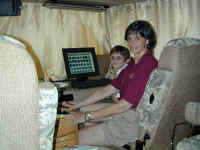
|
Stephanie and Jennifer are at work at our "computer workstation,"
which is the flat front dash in our RV. It works perfectly to hold
our flat panel screen, keyboard, wireless mouse and our cell phones
for data connections to the internet. They are reviewing a number
of our digital pictures which we will edit and put the best on these web
pages. We are having fun doing this, but it still takes a little
too much of our precious time! School work needs to be a top
priority.
|
While we’ve not yet established
a routine, the real purpose of our trip has begun. Steph has officially finished
fourth grade (we presume), vacation has wound down and we’ve moved on to the fifth grade curriculum in
earnest. The first units on emigration and pre-revolutionary America are winding
up, and we’re getting into the War for Independence, hopefully to begin
working through the Constitution before we hit DC. Here's a recap of early
June.
Our Cape Cod vacation continued
with a fascinating day touring Woods Hole Oceanographic Institute (the home of
Alvin, the sub that discovered the Titanic); we marveled at the utopian feel of
this small sea-oriented town with high powered university underpinnings due to
the well established graduate programs in oceanography. We also enjoyed a perfect day biking around
Nantucket. My jaw hit my chest when we came back into Nantucket Town after an
invigorating ride across the island via a
street which looked like a total flashback to the late 18th Century,
complete with cobblestone streets, original architecture, gaslights and
carriages. Even the foliage seemed original, and I have never felt more
completely transported into another century. Since cobblestones and bikes don't
mix, we had the opportunity to cool-down and absorb the town's atmosphere at a
leisurely pace.
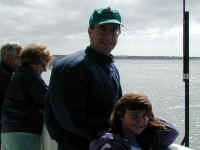
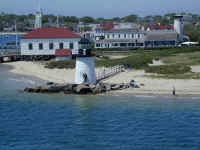
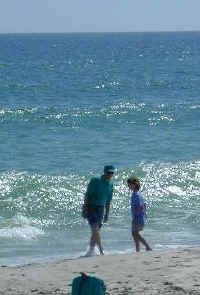
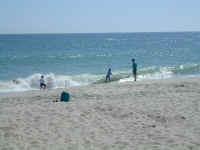
Denny and Stephanie enjoying the
ferry to Nantucket Island. The Nantucket lighthouse and Coast Guard station,
adjacent to Children's Beach. Stephanie and Denny enjoy the large
waves in Madaket about 6 miles from Nantucket Town.
We ended our vacation with a day of
visiting the displays of unlimited wealth in Newport, RI. This seaside town was
summer home to many of the robber barons of the Turn of the [last] Century and
the site of their 30-70-room "summer cottages." We enjoyed tours of Belcourt
Castle (the Belmont estate, lovingly restored by a couple of avid craftsmen and
collectors), the personalized Astors’ Beechwood, and, of course, the Vanderbilt's
overwhelming Breakers. I was pleasantly surprised at the
vestiges of personality each of the homes still retains. Denny had to take an
unexpected break to repair Betty the Bounder’s essential right mirror (torn
off by accident by a much smaller RV maneuvering past us as we waited to depart
our campsite), but duct tape and a little ingenuity saved the day. Repair parts
will be shipped to our DC location (Incidentally, we understand Fleetwood gives
plant tours while you wait for your repairs!!)
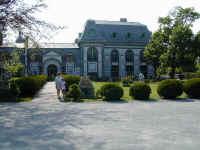
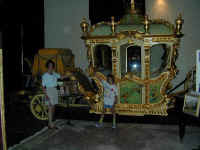
Belcourt Castle, above,
actually looks smaller than it really is. In
the late 1890's, one had to be careful not to be have the summer house look TOO
ostentatious. The gold coach is in the castle and was created from scratch
by Mr. Tinney who has restored the castle so he can display his many, many
beautiful antiques inside. He bought the castle in a total state of
disrepair in the 50's for only $25,000!!
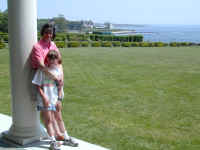
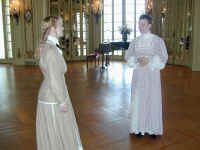
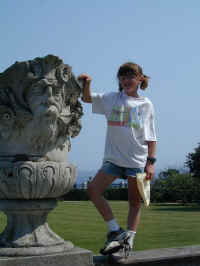
Next, Stephanie and Jennifer
enjoy the large back lawn of Beechwood, summer home of the John Jacob Astor.
Inside this home, the employees dress and act the part of the wealthy
inhabitants in 1896. The last picture shows Stephanie at the Breakers
standing next to an urn with the face of "Wind." The rich from New York came up during the hot part of the summer to enjoy
the nice climate (relatively speaking, of course). But they only came up for 6 weeks in July and August to enjoy
these
"smaller" summer cottages. The rest of the year was spent in
their other 17 houses around the world.
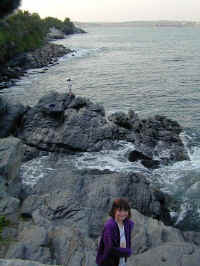
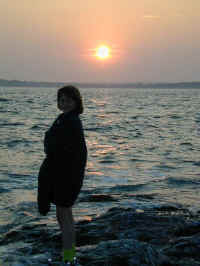
Stephanie enjoys the rocky
Newport beach during a beautiful sunset.
The next few days were spent
camping in a friend’s front yard about an hour outside NYC, thanks to their
unstinting hospitality and a neighborhood without covenants.
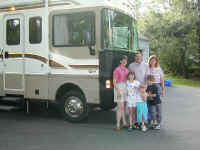
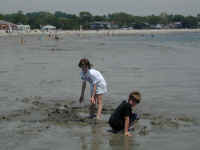
Here is the Humphrey-Saipe
family with Jennifer and Steffi in front of Betty the Bounder (named by Stephanie),
and their house. We occupied a large part of their driveway. Under the
RV, you can see the front hydraulic jacks that are used to level our rig. Unfortunately,
after a full week, we left three dimples in their driveway. Sorry!
The beach scene is at Compo Beach in Westport, CT. The land
goes very gradually into the sea so tides really come in and go out a long
way. Steffi and Matt enjoy digging and finding critters in the fine, soft sand.
We visited Washington Irving’s
home to find traces of the Legend of Sleepy Hollow, and were charmed by
Irving’s apparently full life of culture and innovation. Imagine running hot
water in 1853! It surely must have been one of the first such innovations in the
US! We did find the Sleepy Hollow bridge (nee North Tarrytown) where the
Headless Horseman hurled the pumpkin at poor Ichabod Crane, but it was only the
graveyard which gave us a hint of the original mystery as the bridge itself is
now on a busy highway in the middle of town.
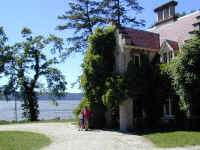
Sunnyside, the retirement home of Washington Irving. The
Hudson River in the background is very wide at this part. Irving loved the river but hated the trains that came by his
house then and still do! Again,
employees dress as they would have in the mid nineteenth century.
A day at Mystic Seaport
acquainted us with the re-creation of the slaves’ "freedom ship"
Amistad, nearing completion for its launch next month, as well as sea chanties,
shipbuilding, and cooperage….tying nicely into our continuing study of
emigration to America.
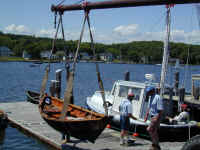
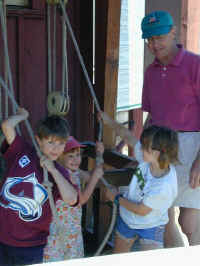
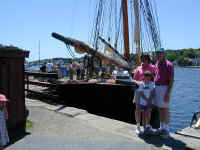
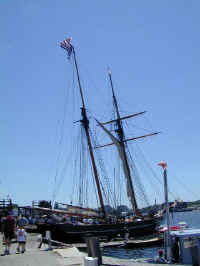
Mystic Seaport is a real
working port. Here a small crane lifts a wonderful wooden dinghy out of
the water to be worked on. Matt and Katie Humphrey and Stephanie learn
about "block and tackle" and how that physical principal helped sailors lift sails
and cargo. It is easier with four rope pullers than one!! The ship
that the Rich Family is standing in front of is the re-creation of the Amistad,
the slave ship depicted in the movie of the same name. It is longer than
the original because it had to have an engine and other things added to meet
Coast Guard requirements today. It will be launched as part
of the Operation Sail 2000 journey of the Tall Ships this summer along the east coast. We definitely
plan to see those ships as part of our journeys, probably near
Baltimore. (For more information, check the Opsail2000 website)
An afternoon at Ellis Island
allowed us barely enough time to absorb the wonderful depiction of the emigrants’
journeys. Though neither of our families actually arrived there, it was an
excellent display, capturing the uncertain entry process of any emigrant, and
capping off our unit on emigration that we’ve been developing since Plymouth.
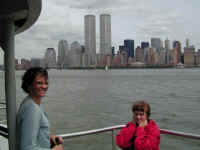
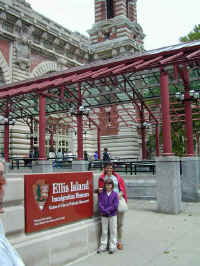
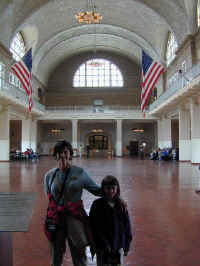
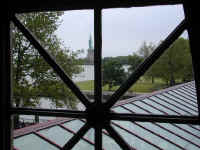
Jennifer and Stephanie
enjoy the short ferry ride from the New Jersey shore to Ellis Island. New
York City with the two large World Trade towers are in the background. The
entry building has been totally restored, while the outer buildings which were
hospitals, etc. are still in disrepair. You can see the main hall where
registration took place. The only difference is that it was very crowded
from 1900 - 1924 with immigrants primarily from Europe. We learned that
the people who came to Ellis Island were those who were in "steerage
class." The first and second class passengers had already been let
off in New York City. It was assumed if you could afford the higher fare, you
would succeed in the US without any assistance. Only 2 percent of the
people coming to Ellis Island were sent back for one reason or another.
The view out the window is of the Statue of Liberty on Liberty Island. Immigrants were often quoted as having cried
with joy when they first saw
the great lady on their arrival.
After being sidelined by a day of
heavy rains and a bad cold, we then spent two days exploring the American Natural History Museum
in NYC, FAO Schwartz, touring the Stock Exchange, and were disappointed that the
UN was closed to tours for an International Women’s Conference. Nonetheless,
we had lively discussions and enjoyed seeing dozens of delegates in their native
dress…and equally colorful native New Yorkers on the subway. Seeing the
refurbished Grand Central Station was a revelation. The gold constellations on
the restored turquoise ceiling give me a renewed appreciation for the incredible
talent the builders and restorers had available to them. What
workmanship!
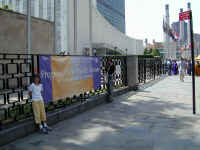
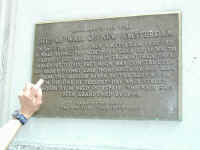
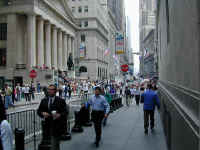
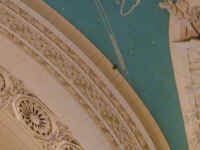
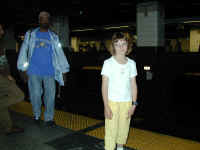
We had to be satisfied
to show the outside of the United
Nations building with the banner from the 2000 World Women's Conference. The plaque on Wall Street
explains how the street name was derived. It was not, as
we had thought, because the buildings made it look like walls!! The New
York Stock Exchange area is very busy. The people are mostly tourists
interspersed with traders in blue jackets who work on the floor of the exchange
and are taking a break. They would NOT let us take pictures of the floor
of the exchange. The ceiling picture is a part of the newly refurbished
Grand Central Station. The small black spot was left just to remind people
how dirty the station was before it was restored!! Finally, here is
Stephanie waiting for a subway train to come and take us somewhere. The
$1.50 fare is worth it because you can get anywhere very quickly. We felt
safe, but might not ride the trains late at night, even though Mayor Giuliani has
really cleaned up the city -- both crime and it's physical
appearance.
Having undoubtedly overstayed our
welcome in CT by a couple days, we packed up to move on to Philadelphia to visit
the cradle of US government. After a quick return trip (forgetting one’s
laundry in the machine has dire implications in this lifestyle), gassing up and
various other delays, we found ourselves right in the worst of New York’s
Friday afternoon rush hour. When traffic was stopped for miles, effectively
blocking our "big rig" from changing lanes anywhere near our exit, we
detoured to Long Island. Not a big problem…until construction and bad signage
dumped us onto surface streets in Queens with no apparent route back to the
freeway. Trusty AAA maps in hand, I navigated through the industrial center of
Queens and Brooklyn back to the highway just in time to see three Manhattan
bridges put ALL their traffic into our lane. Denny does not enjoy this. Two
hours later we sailed into New Jersey and points south, yet another war story
under our belts. For the record, we did not see another RV in the entire New
York metropolitan area. Truckers in Queens are quite attentive. Everyone else
was just incredulous.
We then spent two days pounding
American history into every pore: touring Independence Hall, the Liberty Bell,
Carpenters’ Hall (site of the first Continental Congress), Betsy Ross’s home, the
house where Jefferson wrote the Declaration of Independence, the Franklin
Institute and Franklin Court, site of Ben’s last home and print shop (and
numerous privies). I think most of this history is going to stick. If you go, don’t miss the
John Huston film Independence in the Visitors’ Center…we saw it twice.
And the National Park Service is a wonderful resource.
Several pictures here
from Philadelphia and Independence Park in the middle of downtown:
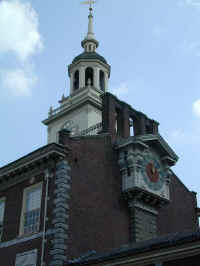
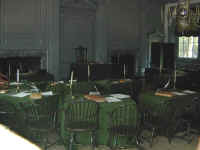
Independence Hall's tower and clocks. This was the
original Pennsylvania state house and was the place where the Declaration of Independence
was debated and signed. It was also the first US Capitol and place where the Constitution was
debated and created after the Revolutionary War was over. The inside picture
shows where John Hancock and later, George Washington, presided over the 13
colonies, then states. There are 13 tables covered in green cloth, one for
each colony's delegates.
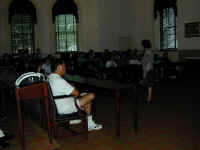
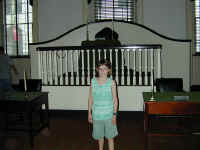
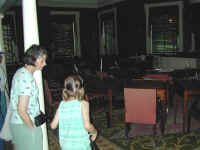
Next to Independence Hall is the building where the first congress was held from
1790 till 1800 when the Capitol of the US was relocated to newly built,
Washington, DC. The first picture is of the House of Representatives
Chamber on the first floor. Stephanie is standing in front of the desk
where the Speaker of the House presided. This
is also the spot where John Adams took the oath of office as the second
president of the US, which was the first test of a peaceful transfer of power of
government. Finally, Jennifer and Stephanie look over the senate chamber
on the second floor, which gave the name to the term for the Senate as the
"Upper"
House.
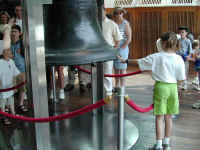
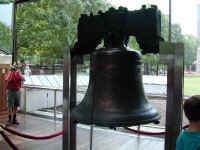
Steffi reaches out to
touch the cracked Liberty Bell. The crack on the front was repaired by
making a wider open space so the bell would ring without a nasty vibration.
After the Revolutionary War was over, the cracked bell was not used until it was
desired to be used for the celebration of George Washington's 100th birthday in
1842. After ringing all morning, a new hairline crack appeared, which you can see
(in person) going to the top of the bell. That silenced the bell forever -- you can
tap it with your fingers, but it is not too loud!!
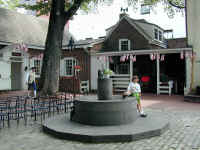
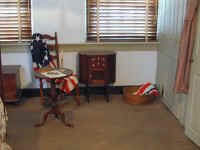
The first picture here
shows Stephanie in Betsy Ross' courtyard. The next picture is where Betsy sewed the first flag for the US. It was flown on US warships starting in
1777 as we made war on the British. Betsy did NOT design the flag, but was
instrumental in getting it created.
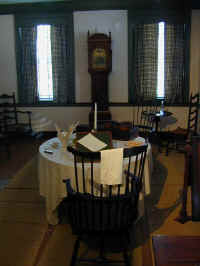
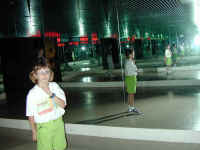
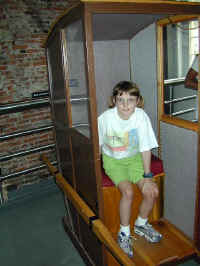
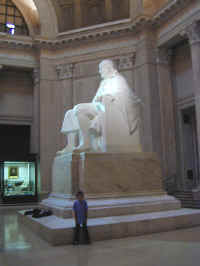
This is a
re-creation of
the room and desk Thomas Jefferson used when he composed the Declaration of
Independence. Since he was from Virginia, he rented a room in this house
when he was in Philadelphia. It is now called Declaration House. The
next two pictures are from the Franklin Court Museum where Ben's abilities in many
roles are chronicled. The seat that Steffi is sitting in was actually used
to carry Ben around during his final years. Finally, Steffi poses beside a
huge statue of Ben at the Franklin Institute, a really great science
museum. She learned a lot about electricity and many other things.
Yes, Ben could have been killed with his lightning and kite experiment!!
On Thursday, we left the city to tour
Henry F. DuPont’s home and gardens outside Wilmington, DE. Though less well known
than its cousin Longwood Gardens, Winterthur is drop dead gorgeous. It is about
960 acres encompassing DuPont’s 20 working farms and estate, of which nearly
100 acres is rolling naturalistic garden: azaleas, rhododendrons, huge sycamores
and oaks, ferns and forget-me-nots, all scattered among numerous springs,
quarries and ponds, completely open for exploring. The 175 period rooms in the
house display American decorative arts and furniture from 1640-1860, with heavy
emphasis on late 18th Century. We saw the original 1815-1830 French
china from which our own set was copied by Limoges, and got tons of lovely
pictures showing lush foliage against misty meadows and hills. Steph is our
official videographer, so you’ll be able to see her narration of the tours in
a few clips when we get home. In all, we’ve been enchanted with the rolling
hills of Delaware, and intend to explore some more over the next couple of days.
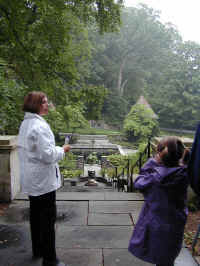
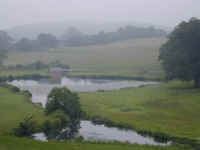
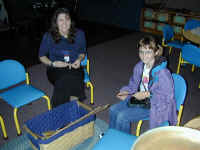
The first picture shows
our guide (a graduate master gardener!) giving us a tour of the Winterthur
grounds showing the old swimming pool. Stephanie, of course, is video
recording the whole thing. The next pastoral scene is of some ponds just
below the main property and gardens. Finally, there is a children's touch
museum where Stephanie got to play with toys from the 18th century. Fun!
Our campground outside
Philadelphia is remarkable for its unobstructed view of a landscaped pond with
30-40 assorted ducks, black and white swans and geese, children fishing and
FIREFLIES every night. Steph has learned to catch them but not yet how to keep
them, and we all delight in seeing the natural twinkle lights in the trees far
into the night. A chorus of frog melodies from the nearby wetlands sings us to
sleep (at least when it’s cool enough to open windows) making it seem leagues
away from the city, though it is only 15 miles by freeway.
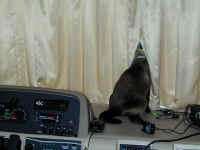
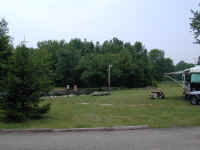
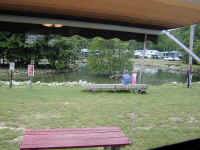
At each stopping spot,
our cat, Java, stays behind to guard our RV, Betty. This is his favorite
spot, sticking his head out the front window curtains watching for any
action. Betty is shown parked in the campground outside
Philadelphia. The pond and the water fowl are seen looking out our kitchen
window.
We’re still too busy, but we
know how lucky we are. Love to all.














































